The art of self healing release your trauma and manifest a new you – The Art of Self-Healing: Release Your Trauma and Manifest a New You—this isn’t just a title; it’s a roadmap. This journey delves deep into understanding the impact of trauma, exploring its various manifestations in our daily lives, from the subtle to the strikingly obvious. We’ll dissect the physical, emotional, and mental symptoms, uncovering hidden coping mechanisms that may be unknowingly hindering your progress.
This isn’t about quick fixes; it’s about a transformative process, a profound shift toward self-awareness and empowerment. We’ll equip you with practical strategies, proven techniques, and a clear understanding of how to release the past and create the future you’ve always envisioned.
Prepare to embark on a powerful exploration of self-healing modalities, from the introspective power of journaling to the transformative potential of therapeutic approaches like EMDR and somatic experiencing. We’ll examine the science behind manifestation, providing a structured plan to set and achieve goals, visualizing your desired future with laser-like focus. Ultimately, this guide will empower you to build lasting well-being, cultivating self-compassion, fostering strong relationships, and embracing a holistic lifestyle that supports your mental and emotional health.
Get ready to reclaim your power.
Understanding Trauma’s Impact
Trauma, a deeply distressing or disturbing experience, significantly impacts our lives, often manifesting in unexpected ways. Understanding these manifestations is crucial for initiating the self-healing process. The effects are far-reaching, impacting our physical, emotional, and mental well-being, often leading to maladaptive coping mechanisms that hinder recovery.
Trauma Manifestations in Daily Life
Unresolved trauma can subtly yet profoundly affect daily routines. Symptoms can range from seemingly minor irritations to debilitating conditions. For instance, difficulty concentrating, persistent anxiety, or sudden emotional outbursts are common manifestations. Physical symptoms like chronic pain, sleep disturbances, and digestive issues are also frequently observed.
Physical, Emotional, and Mental Symptoms of Unresolved Trauma
The consequences of unresolved trauma are multifaceted. Physically, individuals might experience chronic pain, unexplained illnesses, or fatigue. Emotionally, this could translate to intense fear, anger, sadness, or numbness. Mentally, difficulties with memory, concentration, and decision-making are often reported. These symptoms can significantly impact daily functioning and overall quality of life.
Common Hindering Coping Mechanisms
Many individuals develop coping mechanisms to manage the overwhelming feelings associated with trauma. However, some of these, while offering temporary relief, can ultimately hinder long-term healing. These include substance abuse, avoidance behaviors, self-harm, and emotional suppression. Addressing these maladaptive coping mechanisms is vital for effective self-healing.
Types of Trauma and Their Potential Effects
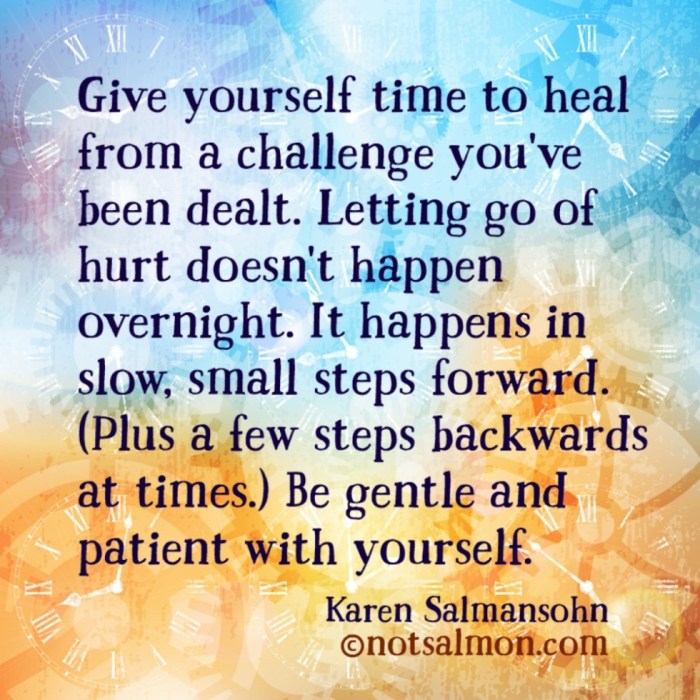
| Type of Trauma | Emotional Effects | Mental Effects | Physical Effects |
|---|---|---|---|
| Childhood Abuse | Anxiety, Depression, Low Self-Esteem | Difficulty with trust, Impaired cognitive function | Chronic pain, gastrointestinal issues, sleep disorders |
| Accidents/Injuries | Fear, PTSD, Anxiety | Memory problems, concentration difficulties | Pain, physical limitations, sleep disturbances |
| Natural Disasters | Grief, shock, overwhelming sadness | Difficulty making decisions, cognitive impairment | Physical injuries, exhaustion, immune system dysfunction |
| Witnessing Violence | Fear, anxiety, nightmares | Intrusive thoughts, flashbacks | Increased heart rate, high blood pressure, digestive problems |
The Process of Self-Healing
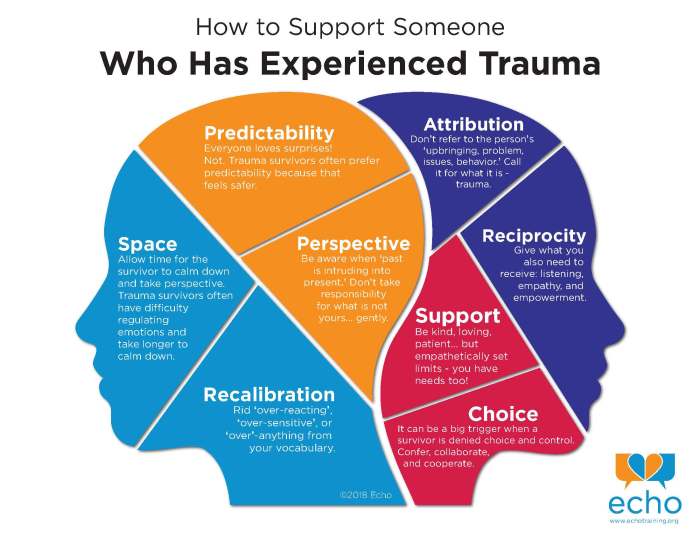
The journey of self-healing from trauma is a personal and often challenging process. It involves several stages, from acknowledging the trauma to actively working towards emotional regulation and building resilience. This process requires patience, self-compassion, and a willingness to confront difficult emotions.
Stages of Self-Healing
The self-healing journey typically progresses through several stages. It begins with acknowledging the trauma and its impact, followed by processing the emotions associated with it. This often involves confronting difficult memories and feelings. Subsequently, individuals work on rebuilding their sense of self and developing healthy coping mechanisms. Finally, they focus on maintaining long-term well-being and preventing relapse.
Building Self-Awareness and Identifying Triggers
Developing self-awareness is paramount in the healing process. This involves paying close attention to your thoughts, feelings, and physical sensations. Identifying triggers—situations, people, or places that evoke traumatic memories or intense emotions—is crucial for managing and mitigating their impact. Keeping a journal can be a valuable tool in this process.
Techniques for Emotional Regulation
- Deep Breathing Exercises: Slow, deep breaths can calm the nervous system and reduce anxiety.
- Mindfulness Meditation: Focusing on the present moment can help to reduce rumination on past traumas.
- Progressive Muscle Relaxation: Systematically tensing and releasing muscle groups can relieve physical tension associated with stress.
- Grounding Techniques: Engaging the senses (touching objects, noticing sounds) can help to reconnect with the present moment.
Resources for Self-Healing
- Therapy (e.g., Cognitive Behavioral Therapy, Trauma-Focused Therapy)
- Support Groups
- Mindfulness Practices (meditation, yoga)
- Self-Help Books and Workshops
Releasing Trauma Through Different Modalities

Various modalities can facilitate the release of trauma and promote healing. Journaling, therapeutic interventions, and mindfulness practices are among the effective approaches. The choice of modality often depends on individual preferences and the nature of the trauma experienced.
Journaling for Emotional Processing
Journaling provides a safe and private space to explore and process emotions related to trauma. Writing about experiences, feelings, and thoughts can help to make sense of the past and promote emotional release. It can also help identify patterns and triggers.
Therapeutic Approaches for Trauma Resolution
Several therapeutic approaches are specifically designed to address trauma. Eye Movement Desensitization and Reprocessing (EMDR) and Somatic Experiencing (SE) are two examples. EMDR uses bilateral stimulation (e.g., eye movements) to process traumatic memories, while SE focuses on releasing trauma held in the body.
Benefits and Limitations of Therapeutic Approaches
While EMDR and SE can be highly effective, they also have limitations. EMDR may not be suitable for everyone, and both require a skilled and experienced therapist. The success of these therapies depends on factors such as the individual’s willingness to engage in the process and the therapist’s expertise.
Mindfulness and Meditation for Emotional Release

Mindfulness and meditation practices cultivate present moment awareness, reducing rumination on past traumas. By focusing on the breath and bodily sensations, individuals can develop a sense of calm and reduce the intensity of emotional distress. Regular practice can foster emotional regulation and resilience.
Manifestation and Creating a New You
Manifestation, the process of bringing your desires into reality through focused intention and belief, plays a significant role in personal transformation after trauma. By setting clear goals and visualizing a desired future, you can actively create a new, healthier self.
Setting Realistic Goals for Personal Growth, The art of self healing release your trauma and manifest a new you
Setting achievable goals is crucial for sustained progress. Start with small, manageable steps. Instead of aiming for a complete overhaul of your life overnight, focus on incremental changes. For example, instead of aiming to completely eliminate anxiety, aim for a 10% reduction in anxiety triggers within a month. This allows for gradual progress and builds self-efficacy.
Visualizing a Desired Future and Building Self-Belief
Visualization involves creating a vivid mental image of your desired future. Regularly engaging in this practice can strengthen your belief in your ability to achieve your goals. This process reinforces positive self-talk and reduces self-doubt.
Visualization Exercise
Close your eyes. Breathe deeply. Imagine yourself in a peaceful, safe place. Feel the warmth of the sun on your skin, the gentle breeze on your face. Notice the colors around you, the sounds you hear.
Feel a sense of calm and peace wash over you. Know that you are strong, resilient, and capable of creating the life you desire. Hold this image in your mind for several minutes, allowing yourself to fully experience the feelings of peace and well-being.
Maintaining Long-Term Well-being: The Art Of Self Healing Release Your Trauma And Manifest A New You
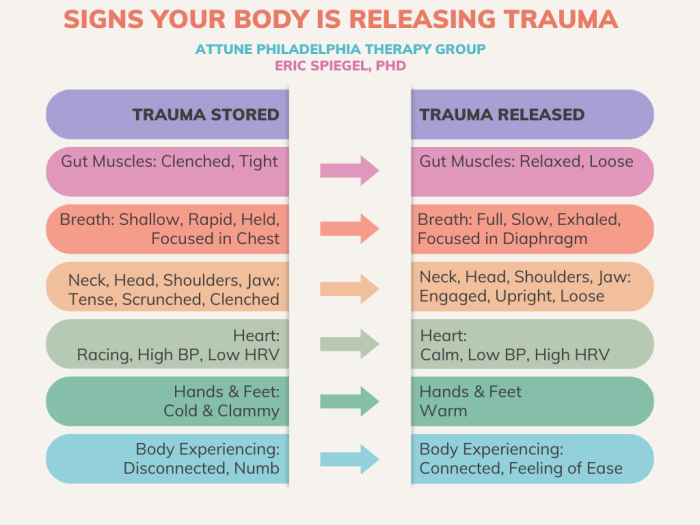
Sustaining long-term well-being after trauma requires ongoing effort and commitment. Preventing relapse, practicing self-compassion, and building a strong support system are key elements in maintaining emotional stability and preventing a return to unhealthy coping mechanisms.
Strategies for Preventing Relapse
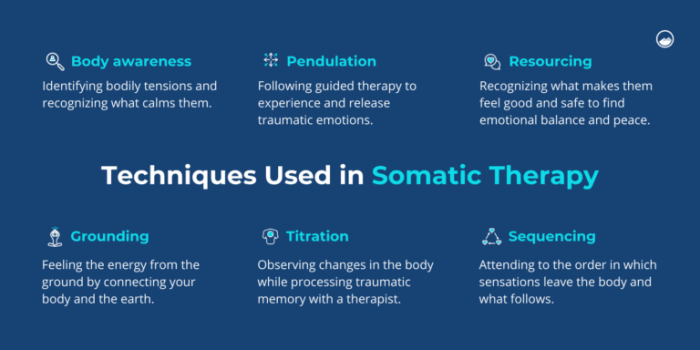
Relapse prevention involves maintaining healthy coping mechanisms, practicing self-care, and seeking support when needed. This includes regular engagement in activities that promote emotional well-being, such as exercise, meditation, or spending time in nature. It also involves having a plan in place for managing difficult emotions and triggers.
Importance of Self-Compassion and Self-Care
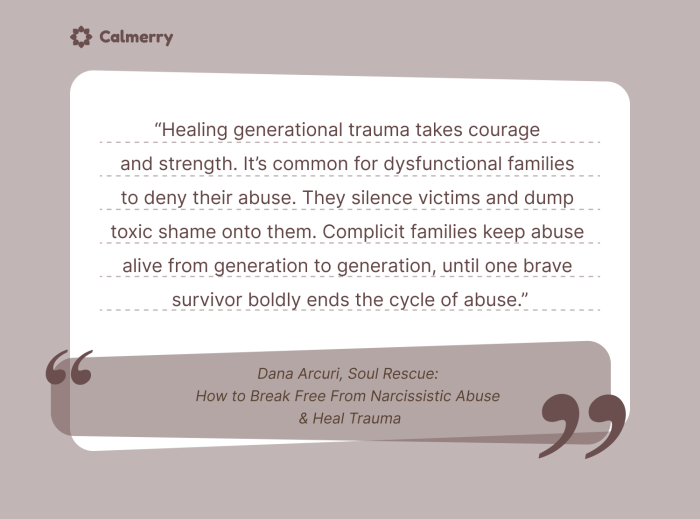
Self-compassion is crucial for healing. Treat yourself with the same kindness and understanding you would offer a friend. Engage in self-care activities that nourish your mind, body, and spirit. This might include regular exercise, healthy eating, sufficient sleep, and engaging in hobbies you enjoy.
Building a Strong Support System
- Connect with supportive friends and family members.
- Join a support group for individuals who have experienced trauma.
- Seek professional help from a therapist or counselor.
Healthy Lifestyle Choices
- Maintain a balanced diet rich in fruits, vegetables, and whole grains.
- Engage in regular physical activity.
- Prioritize getting adequate sleep (7-9 hours per night).
- Limit alcohol and substance use.
Conclusion
Releasing trauma and manifesting a new you is a deeply personal journey, but it’s a journey you don’t have to navigate alone. This guide has provided you with a framework, a set of tools, and a roadmap for understanding and overcoming the challenges of past trauma. Remember, self-compassion is key; celebrate your progress, acknowledge setbacks as learning opportunities, and never underestimate the power of consistent self-care.
By integrating the strategies Artikeld here—from emotional regulation techniques to mindfulness practices and goal-setting exercises—you can unlock your innate resilience and create a life filled with purpose, joy, and lasting well-being. The path to healing is yours to forge; embrace the journey, and watch your transformation unfold.
FAQ Compilation
How long does the self-healing process typically take?
The healing journey is unique to each individual and varies greatly depending on the severity and nature of the trauma. It’s not a race; be patient and kind to yourself.
Can I heal from trauma without professional help?
While self-help resources can be beneficial, seeking professional support from a therapist or counselor is often crucial for processing complex trauma.
What if I experience setbacks during the healing process?
Setbacks are normal. View them as opportunities for growth and learning. Remember self-compassion and seek support when needed.
Is manifestation a scientifically proven method?
While the scientific community is still exploring the mechanisms of manifestation, its effectiveness in goal-setting and positive thinking is widely acknowledged.